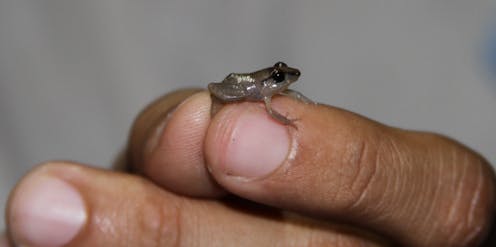Mini creatures with mighty voices know their audience and focus on a single frequency
- Written by Bernard Lohr, Associate Professor of Biological Sciences, University of Maryland, Baltimore County

In the cloud forests of South America, amid the constant cacophony of bird and insect noise, a deafening blare pierces through the background from time to time. Belonging to the loudest known bird, the white bellbird, Procnias albus, this sound would be painful to humans listening nearby and capable of causing immediate hearing damage from about a yard away[1].
Listen to the world’s loudest bird call.Made exclusively by males serenading females[2], these vocalizations can reach peak levels of more than 120 decibels on the sound pressure level scale (dB SPL), which is equivalent to a jet aircraft taking off from 100 yards away[3]. The female bellbird listens some distance from the male[4], presumably trading off being close enough to assess his quality as a mate without damaging her ears.
I study the hearing ability of animals and the sounds they make[5] to communicate. A great number of calls exist throughout the animal kingdom – and many are used to attract mates or defend territories. Evolution has favored those able to make sounds efficiently. The louder and more focused[6] the energy in the call and the closer in pitch[7] it is to the intended listener’s optimal hearing range, the farther away a potential mate or rival will hear it.
Many large mammals, such as singing whales, roaring lions and rumbling elephants, produce loud low-pitched sounds[8] that travel especially well through most habitats. Because of their petite physical size, small animals are not capable of making these far-reaching low-frequency sounds.
As a workaround, a number of small creatures have found ingenious ways to deliver their messages loudly, despite their size.
Ultrasonic calls
Human ears are most sensitive to the highest notes on a piano[9] – about 4 kHz – a unit of measurement that is the physical metric for pitch. Anything above 20 kHz is considered ultrasonic – undetectable to human ears. But such sounds are not undetectable to all ears.
For example, the greater bulldog bat, Noctilio leporinus, can produce ultrasonic echolocation calls between 30 and 60 kHz[12] when hunting prey and maneuvering during flight. These calls can also get incredibly loud – above 140 dB SPL[13].
Many other small mammals, including other bats, and even some primates such as tiny tarsiers, produce loud ultrasonic sounds humans can’t perceive[14]. In part, these sounds can reach such volumes because their acoustic power is concentrated in a pure tone or single frequency.
Creating speakers
Insects are some of the smallest animals to produce loud sounds, chief among them the cicadas and the orthopterans, which include katydids, grasshoppers and crickets.
In North America, the robust conehead, Neoconocephalus robustus, a type of katydid, regularly surpasses 105 dB SPL[15]. These calls are produced to attract mates and, like many such calls, are competing against a clamor of comparable sounds from similar species.
Some insects go one step further, amplifying their sounds by building the functional equivalent of audio speakers. Some tree crickets chew holes in leaves, place their vibrating wings in the opening and use the surrounding leaf as a baffle[18] to prevent the loss of sound energy around the edges of their wings.
Mole crickets, Gryllotalpa vineae, go even further by constructing a burrow that acts like a wind instrument[21], creating a cavity of vibrating air that amplifies the sound energy they produce. These crickets’ songs can travel almost half a mile[22] (0.8 kilometer).
Irksome invaders
The official mascot of Puerto Rico[23] is a 1-to-2-inch (2-5-centimeter) frog called the coquí, Eleutherodactylus coqui, whose call is a combination of two pure tones – “ko” and “kee,” from which it gets its name. At 114-120 dB SPL, the frog’s calls are so loud they actually must protect their own hearing when vocalizing[24], by increasing the air pressure inside their middle ear.
Unfortunately, in the past few decades humans have accidentally introduced the coquí[25] to a number of areas outside their native range, in particular the Hawaiian islands, where they have no natural predators[26] and have become invasive pests[27]. Since coquí calls are within an octave of humans’ best hearing – and they’re nocturnal – many Hawaiians suffer sleep disruptions because of the tiny frogs[28].
So even if you’re small, it’s not impossible to make yourself heard. You just have to blast all your acoustic energy in a single frequency, and hit the sweet spot of your audience’s hearing.
References
- ^ immediate hearing damage from about a yard away (www.cdc.gov)
- ^ Made exclusively by males serenading females (doi.org)
- ^ jet aircraft taking off from 100 yards away (planenerd.com)
- ^ The female bellbird listens some distance from the male (doi.org)
- ^ hearing ability of animals and the sounds they make (scholar.google.com)
- ^ louder and more focused (doi.org)
- ^ closer in pitch (doi.org)
- ^ produce loud low-pitched sounds (doi.org)
- ^ highest notes on a piano (www.researchgate.net)
- ^ Thomas Cuypers/flickr (www.flickr.com)
- ^ CC BY-NC-ND (creativecommons.org)
- ^ ultrasonic echolocation calls between 30 and 60 kHz (doi.org)
- ^ incredibly loud – above 140 dB SPL (doi.org)
- ^ loud ultrasonic sounds humans can’t perceive (doi.org)
- ^ regularly surpasses 105 dB SPL (doi.org)
- ^ Patrick Coin/flickr (www.flickr.com)
- ^ CC BY-NC-SA (creativecommons.org)
- ^ use the surrounding leaf as a baffle (doi.org)
- ^ Ian Alexander, new drawing based on Bennet-Clark, 1970 with public domain insect from Lydekker 1879 (en.wikipedia.org)
- ^ CC BY-SA (creativecommons.org)
- ^ constructing a burrow that acts like a wind instrument (doi.org)
- ^ These crickets’ songs can travel almost half a mile (doi.org)
- ^ official mascot of Puerto Rico (welcome.topuertorico.org)
- ^ protect their own hearing when vocalizing (doi.org)
- ^ introduced the coquí (www.pbs.org)
- ^ where they have no natural predators (www.oahuisc.org)
- ^ have become invasive pests (www.biisc.org)
- ^ sleep disruptions because of the tiny frogs (www.nps.gov)














